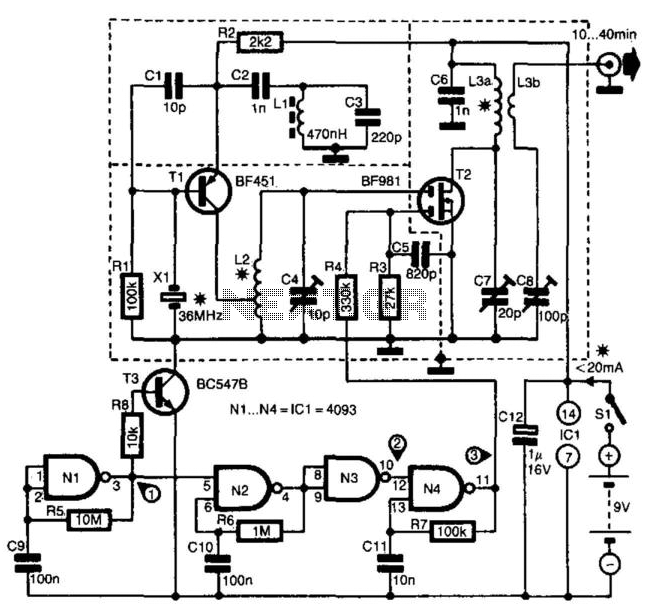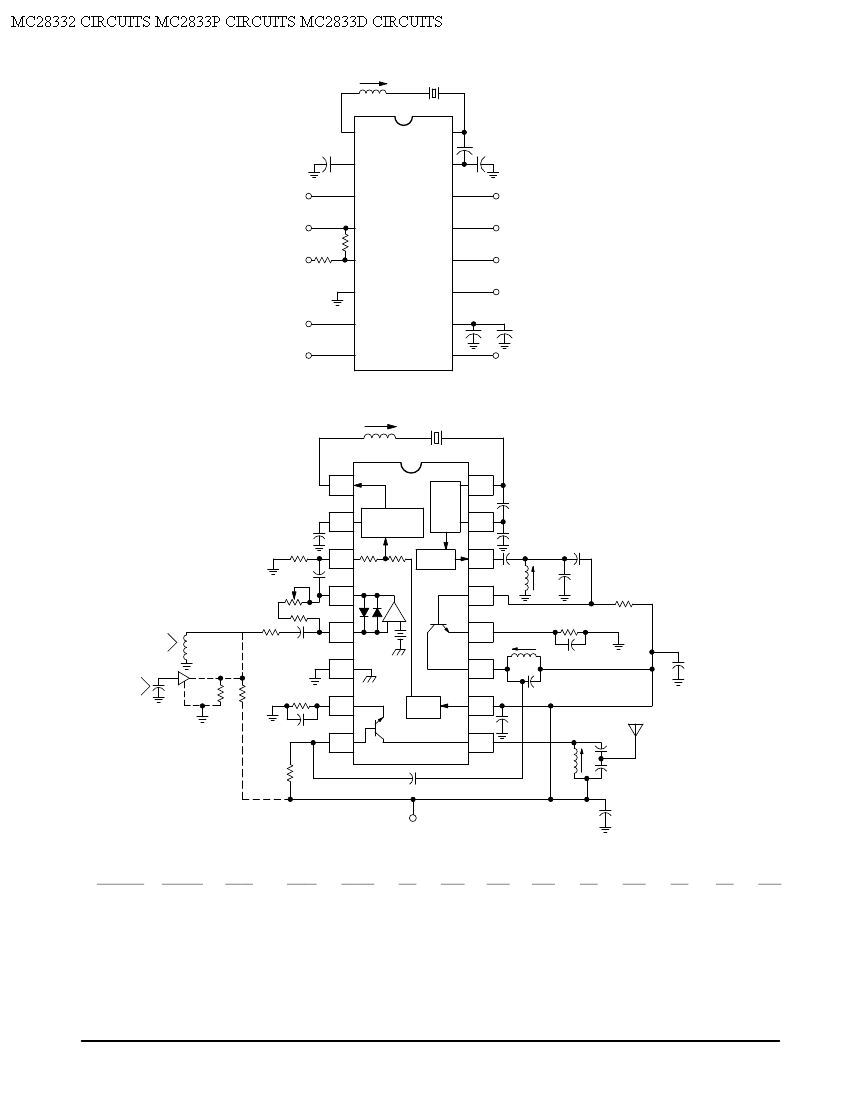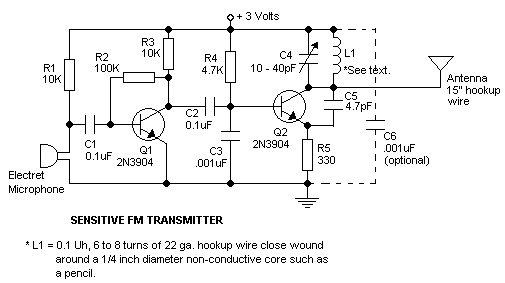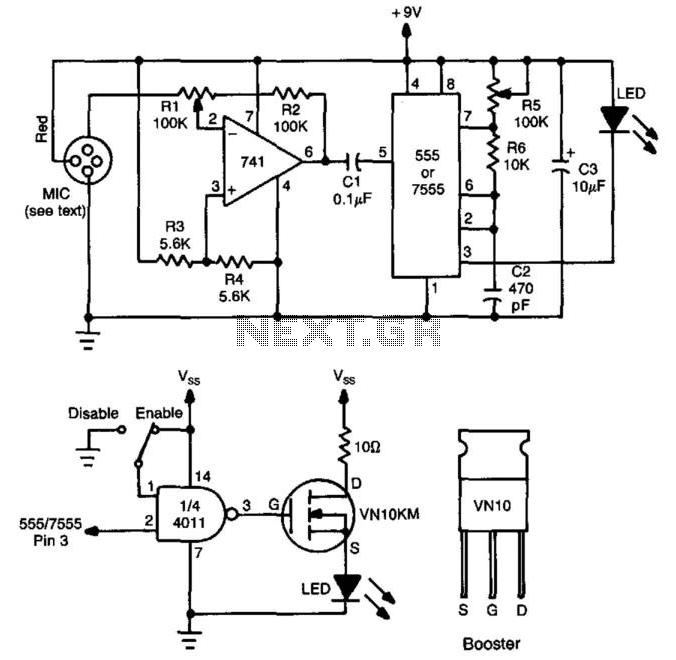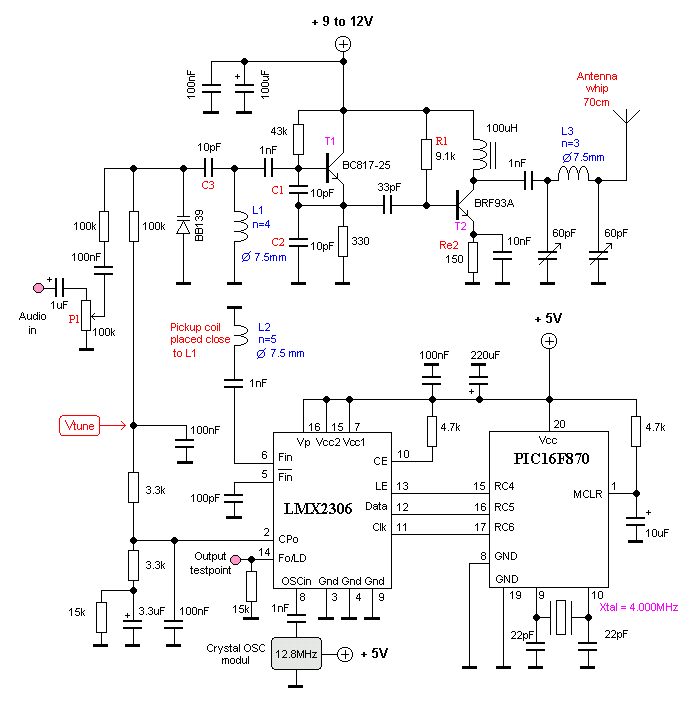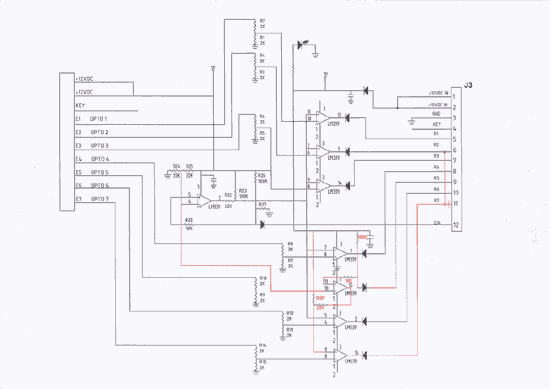
sensitive FM Transmitter
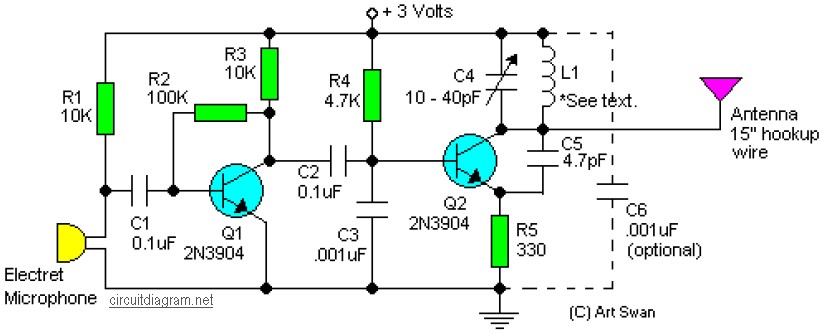
A simple and easy-to-build FM transmitter circuit that requires only two transistors. Typically, the default capacitor model is ceramic, preferably the NPO 1% type or an equivalent. However, almost any capacitor can be used in this circuit, but electrolytic or tantalum capacitors should be avoided. Additionally, there is a diagram for an FM tracking transmitter based on four transistors, with no further notes provided for this diagram. The components list includes: R1 = 100K Ohms, R2 = 10 Ohms, R3 = 47K Ohms, R4 = 220 Ohms, C1 = 4.7uF/16V, C2, C5 = 1nF, and C3 is unspecified. There is also a shortwave HF band transmitter circuit based on the IC BEL1895, which operates between 6 MHz and 15 MHz and can be used for short-range communication and educational purposes. This circuit includes a microphone amplifier, a variable frequency oscillator, and modulation amplifier stages. Transistor T1 (BF195) is part of this setup. Additionally, a simple audio pre-amplifier circuit using a single transistor (2N3904) is described, which provides good gain for weak audio signals, such as those from an electret microphone, and can be used in front of an RF oscillator to create a highly sensitive RF transmitter.
The FM transmitter circuit is designed for simplicity and efficiency, making it suitable for hobbyists and educational projects. The core of the circuit consists of two transistors that facilitate the modulation of audio signals onto a carrier frequency. The use of ceramic capacitors, particularly of the NPO type, ensures stability and minimal drift in frequency, which is crucial for maintaining clear audio transmission. The circuit can function effectively with alternative capacitors, provided they are not electrolytic or tantalum, to avoid distortion and inefficiencies.
The FM tracking transmitter, which utilizes four transistors, expands upon this basic design and allows for more complex signal tracking and modulation capabilities. This feature makes it ideal for applications where precise frequency control is necessary. The components listed, including resistors and capacitors, are selected to ensure optimal performance across the specified frequency range.
The BEL1895-based shortwave transmitter circuit represents a more advanced application, allowing operation in the HF band. This circuit is particularly valuable for short-range communication projects and educational demonstrations of radio frequency transmission principles. The inclusion of a microphone amplifier, variable frequency oscillator, and modulation stages enhances the circuit's capability to transmit audio effectively over a distance.
The audio pre-amplifier circuit using the 2N3904 transistor serves as a crucial component in boosting weak audio signals. This pre-amplifier can significantly improve the performance of the RF transmitter by ensuring that the audio input is strong enough to modulate the RF signal effectively. The design allows for a straightforward integration with RF oscillators, making it an excellent choice for creating sensitive RF transmitters that respond well to audio input.
Overall, these circuits illustrate fundamental principles of radio frequency transmission and audio amplification, providing a practical and educational experience for users interested in electronics and communication technologies.Simple and easy build of FM transmitter circuit. The circuit only require 2 transistors. Circuit Notes: Typically the default for the capacitors model is ceramic, preferably the npo 1% type or equivalent. However, generally almost nothing critical right here. Work with any capacitor you`ve laying arround, but DO NOT use any electrolytic or tantal um. The following diagram is the FM tracking transmitter based on 4 transistors. No additional notes for this tracking transmitter diagram, try to discover this circuit by yourself. :) Components list: R1 = 100K Ohms R2 = 10 Ohms R3 = 47K Ohms R4 = 220 Ohms C1 = 4. 7uF/16V C2, C5 = 1nF C3 =. Here the SW transmitter circuit based on IC BEL1895. This particular transmitter circuit works in shortwave HF band (6 MHz to 15 MHz), and can be applied for shortrange communication and for educational purposes. The circuit is composed of a mic amplifier circuit, a variable frequency oscillator, and modulation amplifier stages.
Transistor T1 (BF195) is. This is a simple audio Pre-Amplifier with single transistor 2N3904. This easy circuit provides good gain to weak audio signals such as electret microphone. Use it in front of an RF oscillator to make an RF transmitter that`s very sensitive to sound. 🔗 External reference
The FM transmitter circuit is designed for simplicity and efficiency, making it suitable for hobbyists and educational projects. The core of the circuit consists of two transistors that facilitate the modulation of audio signals onto a carrier frequency. The use of ceramic capacitors, particularly of the NPO type, ensures stability and minimal drift in frequency, which is crucial for maintaining clear audio transmission. The circuit can function effectively with alternative capacitors, provided they are not electrolytic or tantalum, to avoid distortion and inefficiencies.
The FM tracking transmitter, which utilizes four transistors, expands upon this basic design and allows for more complex signal tracking and modulation capabilities. This feature makes it ideal for applications where precise frequency control is necessary. The components listed, including resistors and capacitors, are selected to ensure optimal performance across the specified frequency range.
The BEL1895-based shortwave transmitter circuit represents a more advanced application, allowing operation in the HF band. This circuit is particularly valuable for short-range communication projects and educational demonstrations of radio frequency transmission principles. The inclusion of a microphone amplifier, variable frequency oscillator, and modulation stages enhances the circuit's capability to transmit audio effectively over a distance.
The audio pre-amplifier circuit using the 2N3904 transistor serves as a crucial component in boosting weak audio signals. This pre-amplifier can significantly improve the performance of the RF transmitter by ensuring that the audio input is strong enough to modulate the RF signal effectively. The design allows for a straightforward integration with RF oscillators, making it an excellent choice for creating sensitive RF transmitters that respond well to audio input.
Overall, these circuits illustrate fundamental principles of radio frequency transmission and audio amplification, providing a practical and educational experience for users interested in electronics and communication technologies.Simple and easy build of FM transmitter circuit. The circuit only require 2 transistors. Circuit Notes: Typically the default for the capacitors model is ceramic, preferably the npo 1% type or equivalent. However, generally almost nothing critical right here. Work with any capacitor you`ve laying arround, but DO NOT use any electrolytic or tantal um. The following diagram is the FM tracking transmitter based on 4 transistors. No additional notes for this tracking transmitter diagram, try to discover this circuit by yourself. :) Components list: R1 = 100K Ohms R2 = 10 Ohms R3 = 47K Ohms R4 = 220 Ohms C1 = 4. 7uF/16V C2, C5 = 1nF C3 =. Here the SW transmitter circuit based on IC BEL1895. This particular transmitter circuit works in shortwave HF band (6 MHz to 15 MHz), and can be applied for shortrange communication and for educational purposes. The circuit is composed of a mic amplifier circuit, a variable frequency oscillator, and modulation amplifier stages.
Transistor T1 (BF195) is. This is a simple audio Pre-Amplifier with single transistor 2N3904. This easy circuit provides good gain to weak audio signals such as electret microphone. Use it in front of an RF oscillator to make an RF transmitter that`s very sensitive to sound. 🔗 External reference
